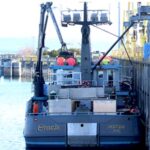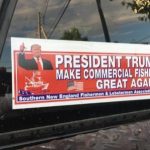Pollution Kill of ’76
 In the early summer of I 97 6, the New York Bight experienced an algae bloom of unprecedented proportions. Before it u,as over. the EPA estimated that over 2500 square miles of ocean bottom from offshore Long Island, NY south to nearly Atlantic City, NJ experienced kill ratios of bottom dwellers that ranged from an estimated low of 40% to as high as 99.5%.
In the early summer of I 97 6, the New York Bight experienced an algae bloom of unprecedented proportions. Before it u,as over. the EPA estimated that over 2500 square miles of ocean bottom from offshore Long Island, NY south to nearly Atlantic City, NJ experienced kill ratios of bottom dwellers that ranged from an estimated low of 40% to as high as 99.5%.
It was the largest manmade ecological disaster ever known up until that time. (Note – In the 80’s, it was brought out the Russians had sort of nuclear accident in the 50’s that was magnitudes bigger but it was unknown outside of Russia in 1976.)
How it came about was, there was algae bloom some 40-50 miles east of NJ and south of Long Island. Nothing new about that, algae blooms have been around since the dawn of time. What happens is that a fortuitous confluence of elements come together (Cou1d be winds, tides, temperature, specific nutrients -nitrogen – oxygen- phosphates – etc., low predator population, water chemistry, any number of things known and/or unknown) at a place where a particular type of algae are able to take advantage of them. This particular spring there happened to be an unusual amount of South Westerly breezes and I suspect that had an effect as I’ll explain later.
The algae then expand and multiply to a point where they completely use up or overwhelm one of the factors or the factors change (sunlight, temperature, etc) where it can no longer support the bloom any more. The bloom then dies out. The cause of the die off (or limit of the bloom) is called a “limiting factor”.
What happened in this case was the bloom reached the sewage sludge dump area 12 miles east of Long Branch, NJ, where the sludge residue from the sewer plants of New York City, much of Long Island, and northern New Jersey (a region with probably close to 20,000,000 people, and let me tell you, that’s literally a lot of shit) was dumped on an almost daily basis Here the bloom found a brand new source of “food” and expanded explosively.
What made this particular bloom devastating was that this particular form of algae was Certium Tripos and had the most unusual characteristic of being able to change
(metamorphosis) its manner of “feeding” from osmosis (where it absorbed food) to becoming a “meat” eater. When it hit the sludge dump area (sludge being more than 90olo liquid, it spreads over many miles before the solids finally, if ever, hit the bottom), it found a veritable feast of food and got busy. It changed form and got into some serious dining. (I always picture those little round balls opening up vou used to see on television eating all the dirt for Oxytlol soap.’)
Pretty soon it began to reach the limits of its longevity (probably measured in weeks) and began to die off. As it died, it sank to the bottom and rotted. And as it accumulated, it used up all the available oxygen in the decomposition (oxidizing) process, which of course “suffocated” all other oxygen dependent bottom life that couldn’t flee the area.
It probably didn’t affect fish as much (other than destroying food) as they could swim away or up to the surface where there would be plenty oxygen from the wave action. but crabs, clams, worms, anemones, starfish, conches, sand dollars, ……. All died.
The die-off was not an instantaneous process, it took several days or weeks in any given area. As clammers we saw it first in the form of increased catches. The clams were all coming out of the bottom, or staying up longer, to get oxygen; and of course our catches went up. For the first few days or a week, no one realized what was happening. Only that we were getting “hot”.
Finally when the dredges came up with dead clams coming out of their shells, running out down the rings on the bag, dead crabs, smelling, …… Then we knew something was wrong…… What is it? The ocean is dying! They fucking killed it! Who did it? We’ll kill the bastards!
I can still feel the knot my stomach tuned into. Joey Pearce (a skiff fisherman) came to me with a plan to get some C4 (Joey was a Vietnam vet) and blow up the new county sewer treatment plant. We were all angry and frustrated. Nothing we could do.
Within a couple weeks, it had reached nearly to Atlantic City. Listening to the radio one could almost see it working its way south. That’s where the South West wind I talked about before comes in – as it blew the surface water northerly, it must have created a southerly current along the bottom extending the kill area further south. (Envision a conveyor belt – as the surface water moves, something has to replace it. [in other circumstances it has been called “upwelling”.)
I’ve often reflected on the irony of it, on the 200th anniversary of our county, we kil1ed the ocean. (Probably doesn’t really belong here but it’s something that’s been on my mind for 2o years.)
In the months before this happened, I had been getting a lot of ink as President of the National Sea Clammers Association (NSCA). We had just gone through a noisy battle with the State over regulation of the inshore clam beds and a landing tax on clams. The NSCA was less than 25 boat owners but we made a lot of- noise and appeared a lot bigger. (I was always careful to never reveal our size, just “We are the largest organization of boat owners on the East Coast.”, …… stuff like that.)
Dues were pretty stiff (well into the $ 1,000’s per member) and we could afford to hire a lawyer (Charley Sandman, an ex-State Senator and ex-Congressman who had been on the Nixon impeachment committee) and a professional fisheries consultant (Dr. R. Rausch, who had been a salmon fisherman on the West Coast and held two doctorates – Fisheries Biology and Environmental Physiology). Dr. Rausch was the guy who figured out the connection between Cerlium Tripos and the bloom and made sure I understood it all.
At any rate, like I said, I had been getting plenty ink (even the subject of a couple TV shows out of Philadelphia) so naturally reporters would call me for quotes on the kill and of course I always gave them something printable. So I was a natural for a committee that Congressman Jim Howard was forming to “study” the kill.
This was heady business for me and the first (and only as far as I know) meeting was held in the Congressman’s local office in Belmar, NJ. At the meeting was:
. Congressman Howard
. an aide from Washington
. New York Regional Director of the EPA -Jerry Hansler
. Two PhD’s from Hansler’s office
. A couple officers from the League of Women Voters
. A couple officers from The Littoral Society who were divers and had filmed before and after scenes from a local wreck (sickening)
. Reps from a couple more local environmental organizations
. A rep from the party boat industry
. Jack Baker, a local restauranteur of wide reputation
. Matty ????, a local fisherman from Belmar
. Charley Sandman
and me
Any way, the meeting opens up with the Congressman making a “concerned” speech about how hard Congress has worked to stop ocean dumping (it had been, up to then, mandated to stop in ’72, ’76 and then later to in ’81, ’86 and finally did stop around ’89 or 90) and how he hopes we can get to the bottom of things here and straighten them out.
Hansler speaks next about how besieged, beleaguered, underfunded and overworked the EPA is (with some technical bull from his PhDs.). He finishes up by banging the table with his fist and emphatically saying “I’m sick and tired of Congress passing laws to do all this wonderful stuff and not appropriating the money so we can do the job!” (A really impressive performance)
Next comes the divers ‘Before and After film of a local wreck and it was powerful stuff. The Before showed nice clean water with fish swimming around. Crabs, the whole bit. You’da thought it was shot in the Caribbean. The After was ugly. Dirty water, no sign of life anywhere, long stringy shit floating by. Powerful stuff. No arguing with that.
Next comes everybody else in tum expressing concern and how he is glad and relieved to have finally gotten the attention of “the right people” to fix things. (Sandman had skipped out earlier after making a concerned speech on the NSCA’s behalf)
I’m at the end of the table and now it’s my furn. There’s something wrong here. I don’t know what it is, but there’s something wrong. I had a bottle of water a diver friend, Charley Stratton, had given me (*still* got it somewhere). It was a glass quart juice bottle, sortta bell shaped, and had about an inch of sand on the bottom with about a 1/4″ or so of black stuff on top of that and the rest filled with clear ocean water. He had taken a sample from the bottom and had given it to me.
I put the bottle on the table, let it sit there and said “Mr. Hansler, I’m in the surf clam business. I sell clam meat. My customers don’t wanna know the weathers bad. They don’t wanna know my winch is broke down. They don’t wanna know my crew was drunk. The only thing they wanna know is where their clam meat is.”
And with that I took the bottle and shook it a little. The clear water turned instantly black. “And, Mr. Hansler, I don’t wanna know about your problems. You’re the head of the Environmental Protection Agency and when I look at this bottle of water, you haven’t been doing your job too goddamn well. I wanna know where my clean ocean is.”
Well ….. the room goes dead quiet. “Damn,” I thought to myself, ” I really did it now. Pissed off a Congressman. Got the head of the EPA pissed off. All these nice people here know I’m an ass. Embarrassed Jack Baker and Matty who were friends of mine. Nobody’s gonna wanna know me after this.”
Then, wisely, lie thought to himself. “Well fuck it, I might just as well finish the job.” I took the bottle of water in my hand and said, “Mr. Howard, you’ve been a congressman in this district for 6 years (actually it was 4) and you’ve done a pretty good job. Saved the Fort, brought bacon home to the district and such. But Mr. Howard, when I look at this bottle of water, it’s obvious to me you haven’t done enough, and if you can’t handle the goddamn job, we’ll just have to get someone who can!” And with that I shoved the bottle right in his face.
The Congressman turns sheet white (this was in August or September in an election year him a Democrat and a Republican in the White House), the room goes dead quiet. The meeting’s over.
I stand up to leave and the next thing I know, Hansler’s got his arm around my shoulder. “I want to talk to you. You’re just the kind of guy we need to teil us what’s wrong.” And with that he walks me out of the room, past all the reporters waiting outside for the Congressman’s press release and committee comments. We go across the street and get a beer. Turns out he’s a pretty decent guy and we have a good bull session for a couple hours, and we end up friends (another story).
When I read the paper the next day, it sure didn’t sound like the meeting I was at. All sunny days and roses and everybody’s wonderful and we’re going to fix this tragedy, that’s for sure. Then it dawned on me what Hansler did. I was the only one who would speak up and maybe embarrass the Congressman publicly, so he got me out of there. His PhDs did a rain dance for the reporters and made Howard look good and concerned (picking up an IOU from him). Hansler was really good.
I got even a little bit, though. There was a reporter from the NY Times I knew, (Joe Sullivan) in the bar and I invited him to sit with us without telling Hansler who he was. No harm done but Joe got some good background for news stories later. I knew, a trick or two myself.
Before I forget, I have to pass on a couple other Hansler stories. Like I said, Jerry and I hit it off. He came down to my dock in Point Pleasant Beach one time and I showed him around and introduced him to a couple of the boys. [f he didn’t have an education, he probably couldda been a fisherman himself.]
Liked to drink beer too. We’d hadda few when I was taking a whiz off the dock. He says to me,” Listen, if you ever get a ticket for pollution for doing this, call me and I’ll come down to defend you. This is NOT pollution.:[t’s …..” and went into some long explanation how urine was okay for ocean water.] Then he promptly found his own piling.
Once when I was talking to him a year or two later, he told me that as a result of his talking to some of the boys that day (and what the Kill had done to them) and the lawsuit the NSCA had filed, he forced a town in Long Island to “recharge” (pump back into the ground) their effluent rather than discharging into the ocean. (I kinda think it was more because of salt water intrusion on their water table, but if Jerry wanted us to think we were responsible who am I to argue? Like I said before, he knew how to play the political credit game. His father- in-law was Senator Sam lrvin, the get w-ho chaired the Nixon impeachment hearings.)
By this time we (the NSCA) had filed a lawsuit as a result of the Kill. I had been approached, semi subtly (this was before ambulance chasing really got into full blatancy ), by several lawyers to sue the government for damages but had rejected them. I knew this was a big case and didn’t want to blow it by using minor leaguers.
We were really, really angry and didn’t know what to do. Somebody had to pay for this, and we didn’t mean money. But somebody ought to be made to pay for this. This just wasn’t right. No one should be able to get away with doing something like this.
Anyway one day I get a call from somebody (I forget who) asking me to meet with the lawyers tbr Long Beach Island. Several towns on the Island had gotten together to sue the government for an injunction to stop sludge dumping and we could tag along with their suit.
The LBI lawyers set up a meeting and four or five of us from NSCA met with them to discuss a damage suit against the government. The way it worked was that LBI lawyers were going for injunctive relief (no cash damages) and as we had the most obvious financial damages, we would be a good fit to their suit. (It would have been much more difficult to prove resort damages or even fish landing losses. We had the visual proof) Plus we could piggyback the injunctive suit for minimal expense.
Sounded pretty good to us. The lawyers seemed to be top drawer (They had just won a $40 million suit in a franchise case, told us of some other big ones they were in) so we went along. Having had some experience with lawyers before, the one thing I /we insisted on was a cap on expenses. They said the only expenses we would incur would be those that were legally mandated by the courts, no lawyer time or anything like that. The most those expenses would run would be 57,000. (A couple of years down the road we would be damn glad of that limit when they tried to stick us with some of “their’ time.)
Their edge would come in from any success with the suit. It was a large Philadelphia firm with well over 100 lawyers. associates. secretaries. etc. and if they prevailed on our suit (which would make new law – the right to sue the government for damages). they would be able to raise their fees from say $175 an hour to $250 across the board. (I really don’t remember what the1, charged but it was about twice what local lawyers charged at the time.) Plus the judge would award them “reasonable” fees as well. For some reason, not clear to me then or now, this was not a “normal” damage suit where they would get a third of damages awarded or some such thing.
At any rate they fi1ed suit for $250,000,000 in damages (Validating that figure was not hard – Using government estimates of the biomass of claims in the area, it was just a matter of applying a meat yield per bushel and multiplying it by the “right” price.) and $250,000,000 in punitive damages. It was at the time the second largest civil suit ever filed in the history of the United States. (I don’t know what the largest was offhand) There were 22 defendants,
1. The US Government (appropriate agencies)
2. The EPA
3. The State of New York (appropriate agencies)
4. The City of New York
5. Several large sewer districts on Long Island.
6. The State of New Jersey (appropriate agencies)
7. Several large sewer districts in northern New Jersey.
8. ……
I may have missed some but I remember the total was 22.
At any rate, this lawsuit was a BIG deal and brought a lot more ink. I was getting calls from reporters all over the State and from outside as well.
Dick Van Wagner (an Assemblyman from Monmouth County) asked me to testify at a joint NY and NJ legislative hearing on pollution. Sure, why not? Dick was a good guy and had always been a friend to fishermen.
The hearing was held in North Jersey with maybe a half dozen legislators from each state. I was testifying and Dick was eliciting from me how the Kill came about and how much damage it caused fishermen when this big slobby looking Italian from NY asked a couple of questions. You just knew by looking at him, hearing his thick Brooklyn accent, he smoked big cigars, lived in back rooms, had a sinister bent nose chauffeur, made all kinds of shady deals, – Boss Tweed incarnate, right out of Damon Runyon.
Anyway, he sneers at me,”500 million is a lot of money. And just what would youse people DO with dat kind of money anyway?” You know, like we were some sort of backwater illiterates.
I looked him right in the eye and said, “Well sir, we might just take 40 or 50 million and show you how to build a goddamn proper sewer plant!” And that ended my testimony.
Another time I had to go to New York City and testify at an administrative hearing. In order to sue the city, you must get “permission” by going through a hearing before a city lawyer first.
We were directed to a dreary little room the size of a death row cell, about the same ventilation too, 6 stories below ground level. In we go, three lawyers and me. Inside is a stenographer for the city. She is Haitian or something and can hardly speak English, at least so we could understand it.
Now the lawyers are starting to get a little uneasy. Like I said before these are top drawer talent. Used to working in Federal Courts, where everything is roorny, just so and very “proper”. You almost expect them to be wearing powdered wigs, they’re so proper.
I’m beginning to smell a setup here (I’d worked in the city for a while after I got out of high school) when the hearing officer walked in. He was some pale little guy, you knew the only time he ever saw sunshine was when he walked from the subway stop to the building door. A regular city denizen this guy.
I knew him right away. Not personally of course. But I knew his type and he knew me. Street people we were, both of us. His job was discouraging people from suing the city. He was used to people bouncing off a bus, claiming permanent disabling injury and trying to scam $500 out of the city. And he was going to make damn sure you didn’t try that again. And the stenographer’s job is to make a transcript that is virtually useless for appeal purposes.
This was at a time when the City was broke and threatening to default on its debt. The Municipal Assistance Corporation (MAC) had just been formed and was issuing MAC bonds and there was considerable speculation as to their value.
He starts firing questions at me, the stenographer keeps asking us to “slow down Mon”, the lawyers objecting to his style. Me, I’m doing pretty good, ain’t takin’ it too seriously, but answering every question right on the money, going into the biology into pretty good detail (Raush’s tutoring).
This guy, he knows what’s going down, I know what’s going down, the stenographer knows what’s going down. And we all know we know. But the lawyers don’t know. The guy is making up law right out of his head, “You know according to Paragraph xyz, subsection 92, under heading #6, in the 1937 Public Suing Law, suing the City under these circumstances is private Capitol cafeteria, went to the Court and were directed to front row seats. I gotta tell you, it’s pretty damn impressive.
I thought our guys were far more effective than the government lawyers but what do I know. Sometime later the decision came down and we had lost. It seems that under the law we were suing under, suits have to be filed within 60 days of the damage and we didn’t file until something like 72 days. Something like that.
I’m guessing that if we had filed within 60 days, something else would have been found because it just would have been entirely too disruptive to the system for citizens to be able to sue for damages. It would have opened one hellava can of worms, I know that.
For myself, I’ve never had one regret. Like Don King says, “Only in America”.
The suit, even though we eventually lost, had quite a bit of influence during its life of 3 or 4 years:
. During the course of the suit, we dropped the State of NJ in exchange for their agreement to support any legislation to stop ocean dumping.
. There was the Recharging deal in Long Island by Hansler.
. I was told by an insider in the EPA (not Hansler) they were damn scared of the suit. God forbid they would ever be held accountable for their actions.
. It raised the consciousness of the public at large to pollution and ocean dumping. And it was a helluva an educational experience for me.
End of ” The Great Pollution Kill of ’76 “













































